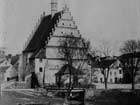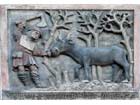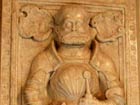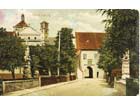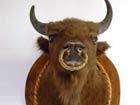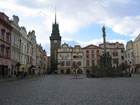History/History/Pernštejn Era
Pernštejn Era
When wealthy Moravian baron Vilém of Pernštejn bought the indebted Pardubice and its surrounding estates at the beginning of the 1490s, he began half a century of Pernštejn rule and the most prominent period in the history of the city and the region as a whole, an era of general prosperity.
Moravian Vilém, who became the Lord High Steward of the Kingdom at that time, logically made efforts to obtain the required base in Bohemia. The Pardubice area suited him because from here he did not have too far to travel to reach the court in Prague or his estates in Moravia. What is more, Vilém saw the local countryside as ideal for creating ponds, more than two hundred of which appeared over the next twenty years, making Pardubice one of the biggest fish farming areas in the land at that time. This is no longer evident; only the remains of the one-time system of ponds are still with us to this day.
Vilém of Pernštejn chose Pardubice, until then a poorly-developed little town, as the centre of his new demesne. After all, he could quite easily transform this little town into the residential town of the Pernštejn family, one of the richest and most influential in the country. Pardubice won town status in 1506. Vilém then issued special town status some six years later: the town had to form the economic background for the Pernštejn court and represent the residence of the leading baron in the land. Vilém’s aim of fundamentally reconstructing Pardubice was accelerated by a major fire in 1507. The magnificent new structures that followed were responsible for the origins of the expression “shines like Pardubice” in the first third of the 16th century. Vilém also newly built the Church of St. Bartholomew (kostel sv. Bartoloměje), where he set up a monastery for the Minorite order. The church was supposed to serve as a family tomb, but of the leading members of the family only Vilém’s son Vojtěch was buried here.
The old water castle also underwent comprehensive reconstruction. It was in place of this that the comfortable Pernštejn family residence was built, protected by a mighty earth mound, castle walls and a wide moat, which was filled with water as necessary. This is the way the chateau grounds remain to this day, unique in contemporary Central Europe.
Another destructive fire hit Pardubice in 1538 and another magnificent transformation was carried out, this time by Vilém’s son Jan in the Renaissance style. Buildings were raised a storey and terracotta lining, portals and arch gables, many of which have remained to this day, were applied en masse. Jan’s builder, Jiřík of Olomouc, also raised the tower of Green Gate (Zelená brána) quite considerably and provided it with a copper roof. Indeed it was the colour of this roof after oxidation that gave the tower its name. The chateau was also adapted to the Renaissance style, the evidence for this we have to this day including highly valued fragments of wall paintings, coffer ceilings and a number of examples of masonry, including the main chateau portal.
However, further generations of Pernštejns were unable to hold on to the Pardubice demesne and the indebted Jaroslav of Pernštejn sold it to King Ferdinand I in 1560, when it became the Imperial-Royal Chamber Estate.
The coat-of-arms of the Lords of Pernštejn
There is a legend surrounding the origins of the Pernštejn family and its coat-of-arms, which features a bison's head with a ring in its nose on a silver and later gold shield. The Pernštejns, in fact, used to present this legend in the form of stone relievo on the dominant structures of a number of their residences. There are three places to find such relievo in Pardubice. The legend has it that there once lived in a forest in Moravia a poor collier called Vojtěch, from whose simple shack somebody (or something) began stealing food. Vojtěch decided to lie in wait for the thief and discovered to his surprise that it was a wild aurochs (European bison). He seized the beast by the horns with all his might, but had no idea what to do next. Just then a little bird sitting on a tree cried to him, “... the bast, the bast ...”. The collier understood and unwound the bast he had around his foot as a shoe, wove a withe from it and shoved it through the bison’s nostrils. He then led the conquered beast to the princely castle, where he cut off its head in one stroke in front of the astonished spectators. For this heroic act of ridding the estate of the raging bison he was given a black bison’s head with a ring in its nose as a coat-of-arms and the forests in which he had previously burned wood coal to build a castle on.

